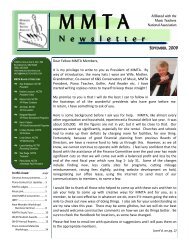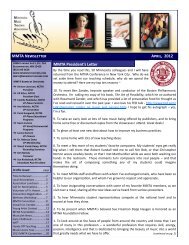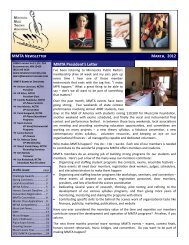January 2013 newsletter - Minnesota Music Teachers Association
January 2013 newsletter - Minnesota Music Teachers Association
January 2013 newsletter - Minnesota Music Teachers Association
You also want an ePaper? Increase the reach of your titles
YUMPU automatically turns print PDFs into web optimized ePapers that Google loves.
16<br />
<strong>January</strong> <strong>2013</strong> [MMTA NEWSLETTER]<br />
Scale Fingerings Help<br />
Sharon Kaplan, NCTM, Piano Exam Development Committee Chair<br />
At the MMTA Visioning Session, there was a request that MMTA provide a book that has all the piano syllabus technical<br />
skills spelled out, with fingerings. And wouldn’t you know, we found someone, Elise Rieke, who is working on that and<br />
is willing to share it with us!! But working everything out and getting it all on paper takes time. We hope to be able to<br />
report something more conclusive in the next issue, at which time we will also give you hints for teaching the skills<br />
without recourse to books if you are so inclined (at least half of those on the committee do not use scale books). Until<br />
then, here are some references that some of our committee members have found helpful.<br />
THE FJH CLASSIC SCALE BOOKS by McArthur/McLean<br />
FJH CLASSIC FIRST SCALE BOOK for Prep - level 2<br />
* Major and parallel minor pentascales<br />
* Cross-hand arpeggios<br />
* Tonic chords (blocked and broken)<br />
* Cadences (I-V-I, I-V(7)-I)<br />
* Major and minor One-octave scales<br />
* Three-note tonic chord inversions<br />
* Cadence I IV V V7 I<br />
* Instructional pages explaining all of the concepts covered in this book<br />
* Quick Guide to Scale Fingering<br />
* Practice guides<br />
* Progress charts.<br />
FJH CLASSIC SCALE BOOK for Level 3 - 6<br />
* Explains concept for Major Scales<br />
* Explains concept for Minor Scales<br />
* One-octave major and minor scales in parallel motion in quarter notes<br />
* Two-octave major and natural, harmonic and melodic minor scales in in parallel motion in eighths notes<br />
* Contrary motion major and harmonic minor scales<br />
* Triads and inversions ,block and broken<br />
* Diminished 7th 4-note chord block<br />
* Diminished 7th arpeggios<br />
* Key note arpeggios.<br />
* Cadence I IV V V7 I and inversions<br />
* Chromatic Scale.<br />
THE BROWN SCALE BOOK: Scales, Chords and Arpeggios for Piano Level 7- 11<br />
This no-nonsense compendium is just the ticket as a reference source for scales and arpeggios. Every key is covered<br />
with major and minor (harmonic and melodic) scales, arpeggios, and chords. There's also a useful repertoire of<br />
practice ideas, contrary motion, third, sixths,...<br />
THE COMPLETE BOOK OF SCALES, CHORDS, ARPEGGIOS & CADENCES<br />
Scale, chord, arpeggio and cadence studies in all major and minor keys presented in a convenient two-page format.<br />
Includes an in-depth 12 page explanation that leads to complete understanding of the fundamentals of major and<br />
minor scales, chords, arpeggios and cadences plus a clear explanation of scale degrees and a two-page guide to<br />
fingering the scales and arpeggios. In addition, several enrichment options are provided with exercises such as<br />
harmonizing scales, accelerating scales expanding scales and much more!<br />
Did You Know? The Piano Exam Resource Reference is a secondary source for the Piano Exam Syllabus. The Piano Exam<br />
Development committee is working to ensure the rep levels in the list agree with the syllabus. Please cross-check<br />
repertoire gleaned from the Resource Reference with the syllabus so that you don’t get a lovely pink slip before<br />
the exam.<br />
You can direct any questions to me, your humble Piano Exam program director, via email: ginachurchskule@gmail.com;<br />
or phone: 651-468-6723.







